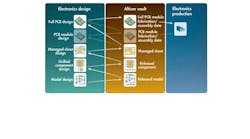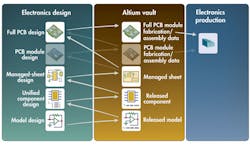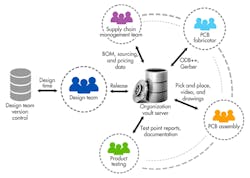What’s The Difference Between Design By E-mail And Synchronized Design Across Multiple Locations?
Over the years, the design process has gone through quite an evolution. What a single designer once accomplished on the back of an envelope now requires a product team of many different designers who may or may not be working in geographically disperse locations, using multiple design tools. While this new process has given rise to some truly innovative and compelling products, it also spotlights a key challenge for modern product teams—namely, how to collaborate effectively.
Related Articles
- What's The Difference Between Ad Hoc And Formal Version Control?
- What's The Difference Between Ad Hoc And The Unified Design Environment For Managing Engineering Change Orders?
- Unified Design Environments Reduce Time-To-Revenue
Good collaboration is essential in enabling product teams to work more efficiently, shorten development time, release products on time, and meet cost targets. It also plays a key factor in determining the success or failure of an organization and the products it produces.
Effective collaboration requires all geographically dispersed project team members—whether from the manufacturing plant in Mumbai or the design teams in Stuttgart and San Diego, to the project director on vacation in the Greek islands—to have shared and controlled access to view, discuss, and utilize design data. That way, everyone in the organization can work on the same model at the same time.
In other words, design teams in the United States and in China could simultaneously work off the same data without having to waste time wondering which version of the model their teammates are working on. But with multiple people working on a design, all in potentially different locations, how can access to the same data be achieved?
This file type includes high resolution graphics and schematics when applicable.
Collaboration By E-mail
The typical way of sharing data between team members involves little more than e-mail, which is pretty alarming considering that 49% of electronics manufacturers report changeovers in the process of converting a line or machine from running one production to another occurring several times in one day. Managing that data across multiple locations via e-mail can be extremely challenging.
It doesn’t take long before mixups occur or revisions don’t match up. Just imagine multiple engineers working on a design. One makes a change and forwards it along to the other team members, who then also make changes and route the design back. In a very short period of time, multiple versions of the design may be flying through e-mail with no one quite sure which one is the most up to date or who is working on what.
Version control offers a remedy to this dilemma. However, even when it is being used, chances are it only enables design-time file versioning and not design release versioning, which would allow the engineer to quickly determine if a design version is final or in the midst of a change. Today, release versioning is often a manual process whereby a paper checklist is used to verify whether or not a specific version of a design is in fact final and ready to be handed off.
Unfortunately, the ad hoc e-mail solution coupled with a lack of appropriate release and design versioning opens the door to a number of potential problems. This might include missed development budgets and missed launch dates, as well as lost time spent looking for shared data. Project teams comprising multiple people, potentially in different locations, require a more effective solution for sharing and controlling their design data.
Remove The Overhead
Engineers and project teams who have ever found themselves e-mailing design files or needing to share files with others in their organization now have an alternative to the traditional e-mail data sharing process. The answer lies in utilization of a role-based configuration management and product release solution that synchronizes design data across multiple locations.
Using this approach, entire design teams can seamlessly communicate across every location of an organization while eliminating errors due to data integrity issues. Access to synchronized design data also guarantees engineers are working on the right version of every file and reduces development time and cost by enabling them to get their designs right the first time.
A role-based configuration and product release management solution is essentially a methodology in which a unified electronic design environment and vault technology are driven, in concert, and used with key design and management practices to fuel a high-quality, high-yield design flow (Fig. 1).
The unified electronic design environment offers the built-in data management, version control support, and advanced graphics system needed for practical and effective collaboration. Vault technology acts as a centralized repository of refined design data (Fig. 2).
Another key aspect of the role-based engineering content management system is its ability to provide release versioning in addition to design versioning. A capability known as vault flow control automatically checks the design against a checklist of criteria. If everything checks out, it is then placed in a central repository. Any engineer who subsequently takes the complete design, or an element of that design, out of the vault is guaranteed that it is safe to use. This feature is especially beneficial to larger organizations with lots of intellectual property (IP) everywhere. It gives them a safe and easy way to keep tabs on the status and history of their IP.
The use of synchronized design data across distributed locations when designing is a valuable tool for any organization to leverage. In fact, according to a 2011 Aberdeen Group report, best-in-class companies are 73% more likely than their competitors to maintain a single product definition with multiple views by role.
For those organizations opting to use synchronized data, the benefits are substantial. It streamlines the design process and improves product development efficiency. Using it, organizations can expect to:
• Meet 90% percent of their cost targets
• Release 90% percent of their products on time
• Realize a 22% percent decrease in printed-circuit board (PCB) development time over a two-year cycle
• Meet 89% percent of their quality targets at design release
Conclusion
When using an ad hoc e-mail solution to share design data across multiple locations, many things can go wrong, such as missed development budgets and launch dates as well as lost time spent looking for shared data.
Modern organizations with project teams comprising multiple people, potentially in different locations, have outgrown this traditional approach. Effective collaboration in today’s design environment requires synchronized design data across distributed locations.
Fortunately, a new methodology based on the use of a role-based configuration management and product release solution provides a way to achieve this goal. It enables engineers to share data (with all of its release and design versioning information attached) from one centralized vault.
Future variants of the solution, however, may allow engineers to move data via copy and paste from one vault to another in a managed way. While the future capabilities of this solution are still evolving, one thing is certain. Whether or not an organization chooses to employ it may ultimately determine its status as best-in-class or just lagging behind the competition.
Marc Depret is a senior product manager for smart data management technologies at Altium in Shanghai. During his more than 16 years at Altium, he has held a number of key posts in its R&D department including director of platform technologies and director of product development. He can be reached at [email protected].



